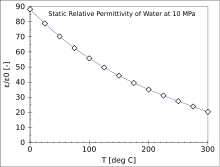
Back ثابت العازل Arabic Адносная дыэлектрычная пранікальнасць Byelorussian Диелектрична константа Bulgarian Permitivitat relativa Catalan Relativní permitivita Czech Διηλεκτρική σταθερά Greek Constante dieléctrica Spanish Suhteline dielektriline läbitavus Estonian گذردهی نسبی Persian आपेक्षिक विद्युतशीलता Hindi
| Material | εr |
|---|---|
| Vacuum | 1 (by definition) |
| Air | 1.00058986±0.00000050 (at STP, 900 kHz),[1] |
| PTFE/Teflon | 2.1 |
| Polyethylene/XLPE | 2.25 |
| Polyimide | 3.4 |
| Polypropylene | 2.2–2.36 |
| Polystyrene | 2.4–2.7 |
| Carbon disulfide | 2.6 |
| BoPET | 3.1[2] |
| Paper, printing | 1.4[3] (200 kHz) |
| Electroactive polymers | 2–12 |
| Mica | 3–6[2] |
| Silicon dioxide | 3.9[4] |
| Sapphire | 8.9–11.1 (anisotropic)[5] |
| Concrete | 4.5 |
| Pyrex (glass) | 4.7 (3.7–10) |
| Neoprene | 6.7[2] |
| Natural rubber | 7 |
| Diamond | 5.5–10 |
| Salt | 3–15 |
| Melamine resin | 7.2–8.4[6] |
| Graphite | 10–15 |
| Silicone rubber | 2.9–4[7] |
| Silicon | 11.68 |
| GaAs | 12.4[8] |
| Silicon nitride | 7–8 (polycrystalline, 1 MHz)[9][10] |
| Ammonia | 26, 22, 20, 17 (−80, −40, 0, +20 °C) |
| Methanol | 30 |
| Ethylene glycol | 37 |
| Furfural | 42.0 |
| Glycerol | 41.2, 47, 42.5 (0, 20, 25 °C) |
| Water | 87.9, 80.2, 55.5 (0, 20, 100 °C)[11] for visible light: 1.77 |
| Hydrofluoric acid | 175, 134, 111, 83.6 (−73, −42, −27, 0 °C), |
| Hydrazine | 52.0 (20 °C), |
| Formamide | 84.0 (20 °C) |
| Sulfuric acid | 84–100 (20–25 °C) |
| Hydrogen peroxide | 128 aqueous–60 (−30–25 °C) |
| Hydrocyanic acid | 158.0–2.3 (0–21 °C) |
| Titanium dioxide | 86–173 |
| Strontium titanate | 310 |
| Barium strontium titanate | 500 |
| Barium titanate[12] | 1200–10,000 (20–120 °C) |
| Lead zirconate titanate | 500–6000 |
| Conjugated polymers | 1.8–6 up to 100,000[13] |
| Calcium copper titanate | >250,000[14] |

The relative permittivity (in older texts, dielectric constant) is the permittivity of a material expressed as a ratio with the electric permittivity of a vacuum. A dielectric is an insulating material, and the dielectric constant of an insulator measures the ability of the insulator to store electric energy in an electrical field.
Permittivity is a material's property that affects the Coulomb force between two point charges in the material. Relative permittivity is the factor by which the electric field between the charges is decreased relative to vacuum.
Likewise, relative permittivity is the ratio of the capacitance of a capacitor using that material as a dielectric, compared with a similar capacitor that has vacuum as its dielectric. Relative permittivity is also commonly known as the dielectric constant, a term still used but deprecated by standards organizations in engineering[15] as well as in chemistry.[16]
- ^ Hector, L. G.; Schultz, H. L. (1936). "The Dielectric Constant of Air at Radiofrequencies". Physics. 7 (4): 133–136. Bibcode:1936Physi...7..133H. doi:10.1063/1.1745374.
- ^ a b c Young, H. D.; Freedman, R. A.; Lewis, A. L. (2012). University Physics with Modern Physics (13th ed.). Addison-Wesley. p. 801. ISBN 978-0-321-69686-1.
- ^ Borch, Jens; Lyne, M. Bruce; Mark, Richard E. (2001). Handbook of Physical Testing of Paper Vol. 2 (2 ed.). CRC Press. p. 348. ISBN 0203910494.
- ^ Gray, P. R.; Hurst, P. J.; Lewis, S. H.; Meyer, R. G. (2009). Analysis and Design of Analog Integrated Circuits (5th ed.). Wiley. p. 40. ISBN 978-0-470-24599-6.
- ^ Harman, A. K.; Ninomiya, S.; Adachi, S. (1994). "Optical constants of sapphire (α‐Al2O3) single crystals". Journal of Applied Physics. 76 (12): 8032–8036. Bibcode:1994JAP....76.8032H. doi:10.1063/1.357922.
- ^ "Dielectric Materials—The Dielectric Constant". Retrieved June 17, 2023.
- ^ "Properties of silicone rubber". Azo Materials.
- ^ Fox, Mark (2010). Optical Properties of Solids (2 ed.). Oxford University Press. p. 283. ISBN 978-0199573370.
- ^ "Fine Ceramics" (PDF). Toshiba Materials.
- ^ "Material Properties Charts" (PDF). Ceramic Industry. 2013.
- ^ Archer, G. G.; Wang, P. (1990). "The Dielectric Constant of Water and Debye-Hückel Limiting Law Slopes". Journal of Physical and Chemical Reference Data. 19 (2): 371–411. doi:10.1063/1.555853.
- ^ "Permittivity". schools.matter.org.uk. Archived from the original on 2016-03-11.
- ^ Pohl, H. A. (1986). "Giant polarization in high polymers". Journal of Electronic Materials. 15 (4): 201. Bibcode:1986JEMat..15..201P. doi:10.1007/BF02659632.
- ^ Guillemet-Fritsch, S.; Lebey, T.; Boulos, M.; Durand, B. (2006). "Dielectric properties of CaCu3Ti4O12 based multiphased ceramics" (PDF). Journal of the European Ceramic Society. 26 (7): 1245. doi:10.1016/j.jeurceramsoc.2005.01.055.
- ^ Cite error: The named reference
IEEE1997was invoked but never defined (see the help page). - ^ Cite error: The named reference
IUPACwas invoked but never defined (see the help page).